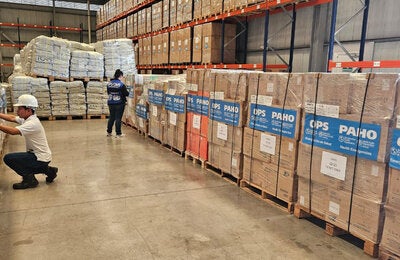Buenos Aires, June 2018 (PAHO/WHO) - A newspaper story reports that two cars collided on a road and three young people died. It is one of many articles published every day about the growing number of road crashes—words that are lost in the sea of information that the population navigates daily. But… were some of the vehicles going over the speed limit? Were there proper road signs and was the road in good condition? Were the vehicles involved in good condition? Had the drivers been drinking alcohol? Were the victims wearing seatbelts?
These and other questions are often not investigated or commented on in the news media, unlike other disasters such as airplane crashes, whose coverage usually includes details on the specific causes and safety conditions involved. These are some of the aspects recently addressed during the workshop on road safety for journalists in South America, held by the Pan American Health Organization/World Health Organization (PAHO/WHO) and the Inter-American Development Bank (IDB) in Buenos Aires, to increase interest and understanding regarding road safety, offer new approaches, and encourage journalism focused on solutions that help to save lives.
More than 20 journalists from Argentina, Bolivia, Chile, Ecuador, Paraguay, Peru, Uruguay, and Venezuela participated in exercises and discussions to identify different ways to improve the way they tell stories about road crashes, which are the leading cause of death among 15-to-29-year-olds worldwide, especially men. The participants explored how their articles could include the factors that lead to road crashes, instead of limiting themselves to simply describing the events.
Nearly half of all the traffic fatalities in the Americas involve road users with minimal protection: motorcyclists account for 20% of road deaths, followed by pedestrians (22%) and cyclists (3%), according to a PAHO report. More than 154 thousand people die on the Region's roads every year, according to 2013 data.
Road safety laws improve the behavior of road users and reduce crashes, injuries, and deaths, explained PAHO's advisor on road safety, Eugenia Rodrigues, during the workshop. In general, the countries of the Region have not done enough to implement measures such as urban speed limits of 50 kilometers per hour or less, seat belt use by all passengers of a vehicle, a blood alcohol limit of 0.05 g/dl, helmet use by all motorcycle riders, and use of child restraint systems.
"The workshop has been a valuable experience, providing us with ways of writing for readers in our countries about these problems that take thousands of lives every year and about solutions going forward," said one of the participating journalists afterward. During the session, participants shared experiences on covering this issue and discussed how to produce writing that contains solutions and recommendations for the population, through exercises led by the WHO technical advisor on road safety communication, Elena Altieri.
Presentations on the condition of infrastructure and vehicles as another of the aspects determining road safety were given, respectively, by Marisela Ponce de León Valdés (strategic advisor on road safety at the Inter-American Development Bank) Alejandro Furas (Secretary General of Latin NCAP). Gador Manzano, health communication specialist at the Inter-American Development Bank, spoke about the use of reliable data and sources.
During the same week, also in Buenos Aires, workshop participants were able to attend the International Child Road Safety Forum, and interview experts from the National Road Safety Agency of Argentina, road safety authorities from Chile and Ecuador, and representatives of the Gonzalo Rodríguez Foundation of Uruguay.
The workshop also included a guided tour, coordinated by the Transportation Department of the City of Buenos Aires, of different initiatives and interventions for road safety and sustainable mobility in the city. This is the second road safety workshop for journalists of the Region of the Americas since a similar activity was held last year in Medellin (Colombia) with media workers from countries of Central America and the Spanish-speaking Caribbean.



